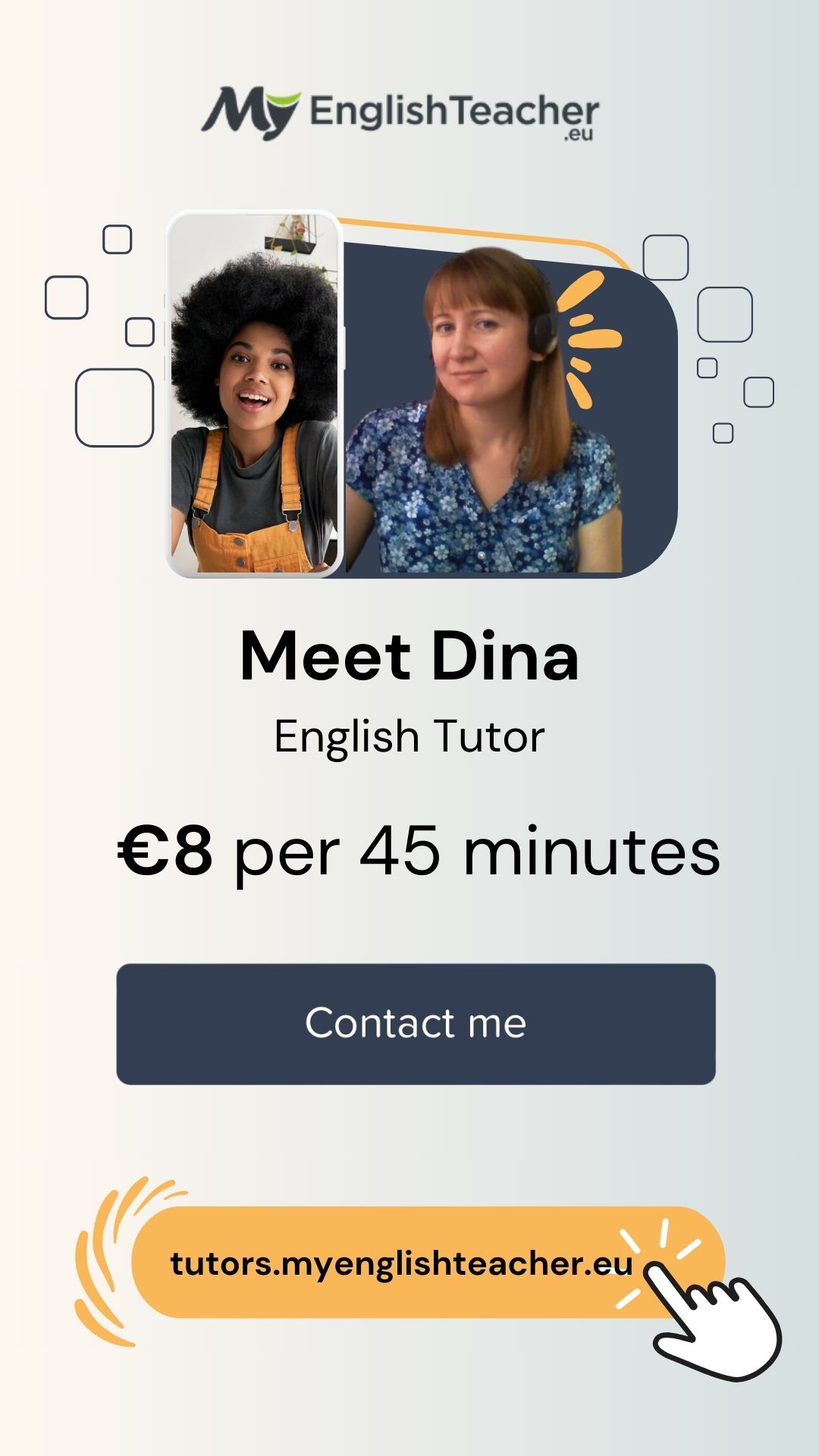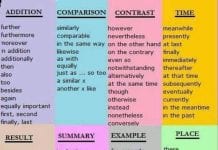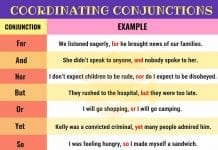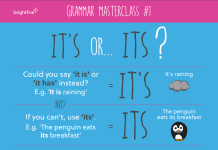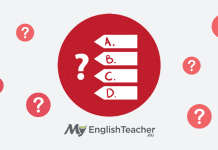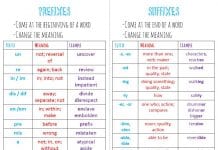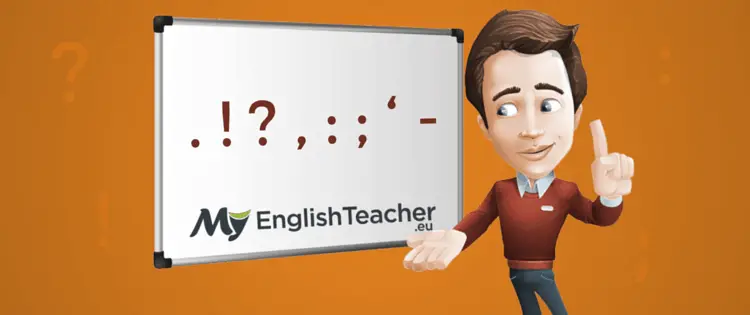
What is punctuation?
Punctuation is a set of conventions or rules. The purpose of these rules is to enable written text to be read easily and accurately. Written text is divided up by punctuation marks, which help to make the meaning of the text clear.
Punctuation rules are not always strictly followed. Some rules, for example, the use of question marks, don’t really change. Other rules, for example, the rules regarding commas, however, can change over time or depending on the style of the writer.
There are some differences in usage between British English and American English, which we will point out as we go along. Both are correct, but it is best to use one form and stick to it.
We are going to look at the following punctuation marks (you can click here):
- full stop
- exclamation mark
- question mark
- comma
- colon
- semi-colon
- apostrophe
- quotation marks / inverted commas
- round brackets
- square brackets
- dash
- hyphen
Full Stop (.)
The full stop is also known as a period in American English.
1. Used to mark the end of a Sentence
Alternatively, a sentence may be closed with an exclamation mark (!) or a
question mark (?).
After any of these three punctuation marks, the next sentence will begin with a capital letter.
- We finished work early on Friday. I wish we could finish work early every Friday!
2. Abbreviations
An abbreviation is a shortened form of a word or phrase.
Some examples include:
- E.g. (Example)
- Etc. (Et cetera – And so forth)
- Thurs. (Thursday)
- Brit. (British)
- Dr (Doctor)
If the abbreviation has the first and last letters of a word, in British English the full stop is not used.
- Doctor – Dr
- Mister – Mr
However, it is common in American English to use full stops or periods in this case.
- Doctor – Dr.
- Mister – Mr.
In British English, the full stop or period is often not used when abbreviating the names of degrees.
- Bachelor of Science – BSc
- Doctorate of Philosophy – Ph
However, it is common in American English to use full stops or periods in this case.
- Bachelor of Science – B.Sc.
- Doctorate of Philosophy – Ph.D.
If the abbreviation is the first part of a word, a full stop should be used.
- Wednesday – Wed.
- January – Jan.
Full stops or periods are never used in the following cases:
- Symbols or units of measurement: Km, min, hr
- Acronyms: UNESCO, NATO, AIDS
- Ordinal adjectives: 4th, 8th, 10th
Recommended for you:
Examples of Conjunction Words in a Sentence!
A Visual List of 100 English IDIOMS FOR TIME with Examples
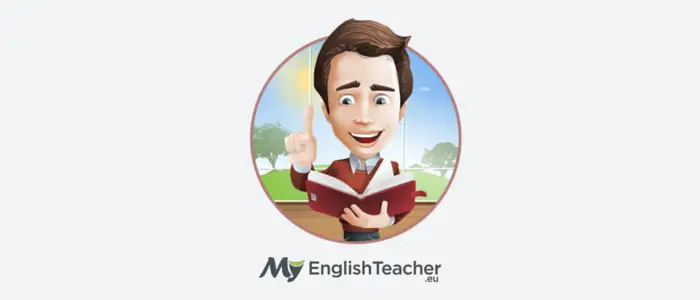
Exclamation Mark (!)
An exclamation mark is used to express a strong emotion, such as surprise, anger or delight. It is placed at the end of the sentence. If an exclamation mark is used, it is not necessary to use a full stop as well.
- Bernice and Ryan are getting married!
- Get out!
It is also used when the writer finds something amusing or ironic.
- It rained every day on our honeymoon!
Recommended for you:
British and American Slang Words
280 Basic English Words You Should Know
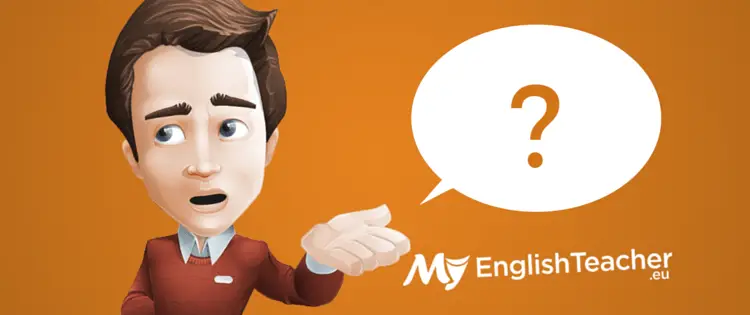
Question Mark (?)
The question mark is used to end an interrogative sentence. An interrogative sentence is a sentence that asks a direct question.
- Have you seen Brian today?
- How long ago did you set up the company?
Do not use a question mark for reported questions.
- He asked her to go to the shop to get a few beers.
Recommended for you:
What’s the difference between direct and indirect questions
How to Form Questions in English?

Comma (,)
Commas are primarily used to indicate pauses in speech and they are used to prevent misunderstanding.
1. Used to separate items in a List
Commas are used to separate three or more words, phrases, or clauses in a series.
- He bought fish, potatoes and vegetables at the market.
There is no comma between the penultimate item in a list and the ‘and/or’, which is sometimes referred to as the Serial or Oxford comma, unless the items in the list are long or it is required to prevent ambiguity.
Compare these two sentences:
- My estate will be divided in equal shares among my wife, my son, my daughter, and my cousin.
- The presence of the comma signals that the estate will be divided in four equal shares
Now, without the Oxford comma:
- My estate will be divided in equal shares among my wife, my son, my daughter and my cousin.
- In this case, the estate would be divided into three equal shares, with the daughter and the cousin dividing their share between them.
2. Used between similar adjectives
Commas are always used between adjectives when they follow be and other linking verbs like look, seem and become.
- She was tall, beautiful and elegant.
- He looks happy, content and self-assured.
Generally, commas are used between adjectives which come before a noun and which give similar kinds of information.
- It was a difficult, stressful time in my life.
Commas are generally not used between adjectives which come before a noun and which give different kinds of information.
- Who is the new attractive employee?
3. Used to introduce or end a piece of direct speech
Generally, a comma is used between the reporting expression and the piece of direct speech.
- She said, ‘I can’t live without you’.
When the reporting expression follows the piece of direct speech, a comma is used before the closing quotation mark.
- ‘She is the best teacher I have ever had,’ said Nadine.
4. Used after an introductory clause, phrase or word
A comma is used after an introductory clause, phrase or word to separate it from the rest of the sentence.
- If you are ever in Colombia, please come and visit me!
- According to Mary, Dee has never been to France.
- However, it was the best we could do at the time.
5. Used to separate two independent clauses that are joined by a co-ordinating conjunction
A comma is used before a co-ordinating conjunction (and, but, or, for, yet, nor, so) between two independent clauses, unless the independent clauses are very short.
- Valerie hates beans and Mike hates fish.
- Valerie ordered fish because she hates beans, and Mike ordered beans because he hates fish.
6. Used to separate non-essential information from the rest of the sentence
Information which is not essential to the understanding of the sentence can be separated from the rest of the sentence by commas.
- Pamela, Martin’s cousin, won the lottery last week!
- Mexico City, one of the biggest cities in the world, is a melting pot of cultures.
7. Unusual word order
A word or words that interrupt the normal progression of a sentence are usually separated by commas.
- My uncle, however, was violently opposed to the marriage.
- Brian O’Driscoll, the Irish Rugby player, bought a house in Spain.
Recommended for you:
Does Therefore Need a Comma?
When to Use a Comma in English? 13 Simple Rules You
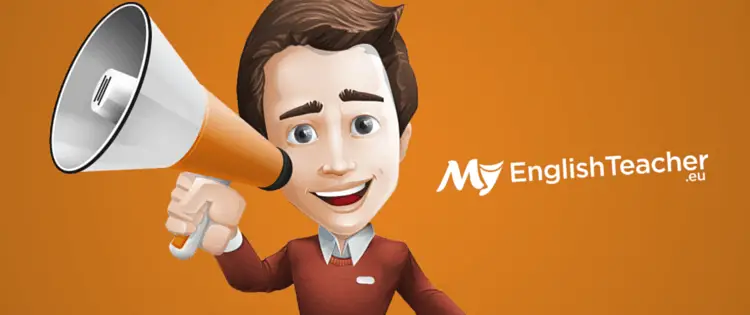
Colon (:)
A colon is used to introduce related information.
1. To introduce lists
The course covers many subjects: history of translation, translation theory, translation technologies, and ethics.
2. To introduce direct speech
Normally, direct speech is introduced by a comma in writing.
- Sarah said, “I wish you didn’t have to go tonight”.
However, if a long passage of direct speech is being introduced or if it is introduced by a name, as in a play, a colon may be used.
- Mary: “I hate it when we argue. We used to get along so well and now it seems like we can’t agree on anything. Maybe we shouldn’t see each other for a while”.
3. To introduce a quotation
- As Gandhi once famously said: “Live as if you were to die tomorrow. Learn as if you were to live forever.”
4. Used between two independent clauses when the second clause explains, illustrates or follows on from the first clause
- We didn’t go on holiday this year: we don’t have any money.
5. Subdivision
A colon can introduce a subdivision of a subject in a heading or title.
Sentences: Interrogative Sentences
6. Opening Salutation of Letters
American English often uses a colon after the opening salutation of a letter. British English, generally, uses a comma or nothing at all.
- American English: Dear Mr. Peters:
- British English: Dear Mr Peters
Note: Capital Letters
British English does not normally use a capital letter after a colon, unless the word would be capitalised in any case or it is the beginning of a quotation.
- We ate so many vegetables: broccoli, carrots, cauliflower, and courgette.
American English often uses a capital letter after a colon.
- We ate so many vegetables: Broccoli, carrots, cauliflower, and courgette.
Recommended for you:
42 Easy to Memorize English Idioms Related to School
Also – Too – Either – So – Neither – As Well

Semi-colon (;)
1. Used instead of a full stop between two independent clauses
When two sentences are grammatically independent but are closely linked or related in meaning, you can use a semi-colon instead of a full stop between the two sentences. The semi-colon highlights the link or relationship between the two sentences.
- Some people love to go to the gym; others love to exercise outdoors.
- The weather has been terrible recently; I hope it improves soon.
A semi-colon can also be used between two independent clauses with a linking word or phrase.
- Andrew loves to party; however, he has calmed down a lot recently.
- Mexico is a beautiful and diverse country; in addition, the food is excellent.
2. Lists
Semi-colons can also be used to separate items in a list, especially when these are long or grammatically complex.
- There are certain conditions that you must meet before you can enter the University: you must be over eighteen years old; you must have studied French, English and Mathematics; you must have paid the enrolment fee in full; you must have given the course administrator a copy of your passport.
Recommended for you:
4 Main Types of Sentence Structures
English Grammar: Sentence Structure in English
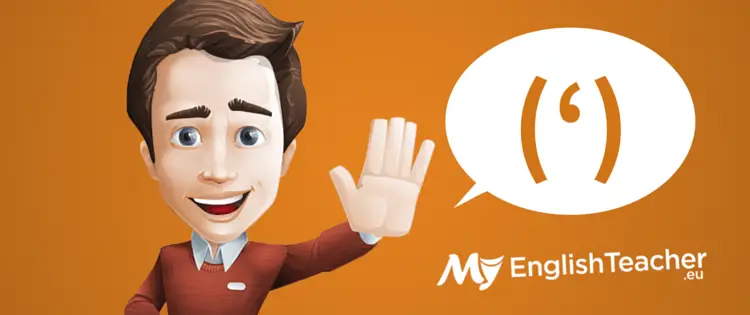
Apostrophe (‘)
1. Used to show possession
An apostrophe is used to indicate that something belongs to someone.
If the noun is singular, add an apostrophe followed by the letter S.
- Harry’s car was broken into last weekend!
If the noun is singular and ends in s, add an apostrophe followed the by letter S.
- The boss’s wife is starting work here next Monday!
If the noun is plural and ends in s, add an apostrophe.
- My three dogs’ fur was so soft and silky after going to the groomers.
If the noun is plural but doesn’t end in s, add an apostrophe followed by the letter S.
- The children’s coats were found behind the sofa.
Note:
Possessive pronouns and determiners do not have apostrophes.
This essay is yours. (Not your’s)
The dog has hidden all of its toys. (Not it’s)
2. Used to show that one or more letters are missing
Apostrophes are used in contractions to show that there is a letter or there are letters missing.
- It’s – It is or It has
- She’d – She would or She had
- Can’t – Cannot
- Didn’t – Did not
Recommended for you:
What are possessive nouns, and how do we use possessive’s
27 Meanings of Most Common Text Abbreviations

Quotation Marks/Inverted Commas (“…”) (‘…’)
Quotation marks are also known as ‘inverted commas’ in British English.
- They can be single: ‘friend’ or double: “friend”.
Single quotation marks are more common in British English, and double quotation marks are more common in American English. However, both are perfectly acceptable, but it is best to choose one style and to stick to it.
Quotation marks are used to separate a word or group of words from the rest of the text.
1. Direct speech
Quotation marks are used when direct speech is quoted.
- Sinead said, “Where were you? We have been waiting for you since yesterday.”
2. Quotations
If a text includes a direct quotation from a person, a book, a report and so on, the quotation must be enclosed in quotation marks.
- One of my favourite quotes of all time is by Einstein – “Insanity: doing the same thing over and over again and expecting different results”.
If the quotation is very long, usually inverted commas are not used and the quote is indented on the page.
- One of my favourite books of all time is ‘East of Eden’ by John Steinbeck and my favourite quote from the book is as follows:
“I believe that there is one story in the world, and only one. . . . Humans are caught—in their lives, in their thoughts, in their hungers and ambitions, in their avarice and cruelty, and in their kindness and generosity too—in a net of good and evil. . . . There is no other story. A man, after he has brushed off the dust and chips of his life, will have left only the hard, clean questions: Was it good or was it evil? Have I done well—or ill?”
3. Titles
Titles may be enclosed in inverted commas in handwritten or printed text, although it is more common in printed text for a title to be written in italics.
- ‘Gone With the Wind’
- ‘The Shawshank Redemption’
4. Special use of words
Quotation marks are used to highlight unusual words or words that are being used in a special way (often in an ironic way) or to distinguish words in a sentence.
Students of English often have a problem with the pronunciation of words like ‘would’, ‘should’ and ‘could’.
- The ‘hadal zone’ is the deepest part of the ocean, starting at a depth of 6000 meters to the bottom of the ocean.
- She said she had never met such ‘intellectuals’ in her life!
If you need to write a quotation within a quotation, use single quotation marks inside double quotation marks, or use double quotation marks inside single quotation marks.
- David said, “I think that ‘Silence of the Lambs’ was the last good movie I watched.”
- David said, ‘I think that “Silence of the Lambs” was the last good movie I watched.’
There are many different and contrasting rules on the positioning of other punctuation marks in relation to quotation marks. However, the basic rule is as follows:
Put any punctuation marks that are part of the original quote inside the quotation marks.
- Sarah said, “Have you seen Tom?”
Punctuation marks which relate to the sentence as a whole are placed outside the quotation marks.
- My favourite film is “Silence of the Lambs”.
Recommended for you:
5 Inspirational Quotes for English Language Learners
What Words To Capitalize in Title?
Round Brackets or Parentheses (…)
Round brackets are also known as parentheses.
1. Numbers and letters in a list
Round brackets are used to enclose numbers or letters in a list.
- (1) Apple Crumble; (2) Cheesecake; (3) Carrot cake
- (a) Chips; (b) Chicken curry; (c) Steak and kidney pie
2. To separate non-essential information
Round brackets are used to enclose information that is not essential to the meaning of the sentence.
Round brackets can be used to enclose additional information, a clarification, a translation, a date, a definition and so on.
If the words enclosed in the round brackets are removed, the rest of the sentence should still make perfect sense.
- George has visited five countries (Argentina, Chile, Bolivia, Peru and Ecuador) since the start of the year!
- Nelson Mandela was released from prison (11 February 1990) after 27 years imprisonment.
- Bake the cake in a preheated oven at 200 degrees Celsius (392 degrees Fahrenheit).
3. Author’s comment
Round brackets are used to enclose a comment made by the author of the text.
- Jhumpa Lahiri (one of my favourite authors of all time) will be signing her new book in New York this weekend.
If the words enclosed in round brackets form a complete sentence, then the period, question mark, exclamation mark, or quotation marks should go inside the round brackets. Otherwise, these punctuation marks should be placed outside the round brackets.
- John had cooked roast beef for dinner. (I don’t eat meat.) So, it was an awkward first date.
- The report (enclosed) sets out the firm’s recommendations for 2016.
Recommended for you:
List of Sentence Connectors in English with Examples!
10 Websites to learn and practice English Grammar

Square Brackets […]
Square brackets are used to enclose words added by another person, someone who is not the original author. The additional words will typically be a comment, a correction, a translation or a reference.
- She [Jerry Hall] was married to Mick Jagger for many years.
When quoting something, if the original quote contains a spelling, grammar or other mistake, this can be highlighted by writing Sic in square brackets after the mistake. It lets the reader know that this is how the original quote was.
- “She hit her [Sic] head as she got out of the car.”
Recommended for you:
English Grammar: Sentence Structure in English
6 Excellent English Grammar Apps for Android
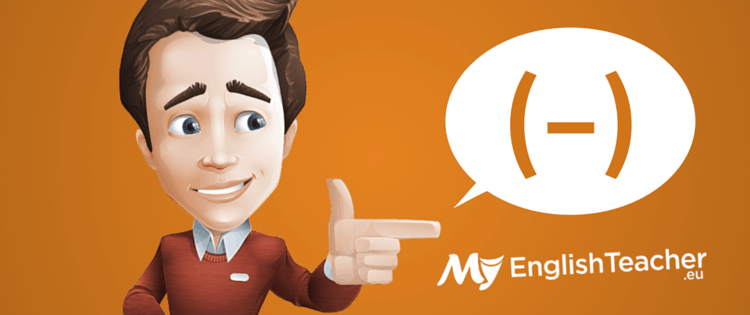
Dash (—) (–)
There are two kinds of dash: an em dash and an en dash. The em dash is longer than the en dash. Dashes are mostly used in informal writing. Normally, there is no space before or after the dash.
Em dash (—)
They can be used in the same way as round brackets, colons, semi-colons and commas.
1. Used in pairs to identify words in parenthesis (enclosed in brackets)
- Harry—Sandra’s brother—is coming to dinner tonight.
2. Used to introduce an example or to expand on what has just been written
- I am taking three exams this weekend—translation theory, specialised translation and translation technologies.
3. Used to introduce an aside by the writer
- Julie walked through the door—she looked amazing.
4. Used in direct speech to show when someone has been interrupted or when they suddenly stop speaking mid-sentence.
- ‘So, we are going to—?’
An en dash is used to show sequences. It is used for time periods, instead of the word to.
- January 2013–September 2015
- 1–100
- A–Z
Increasingly, the em dash is being replaced with the en dash with a space before and after it.
Recommended for you:
Formal and Informal Greetings Email Phrases
Best English Grammar and Spelling Checkers Online
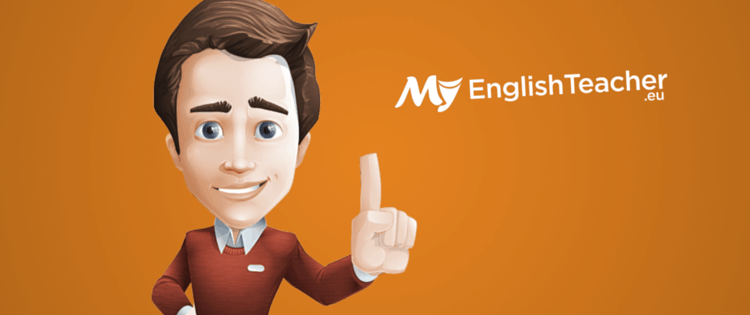
Hyphen (-)
Hyphens should not be confused with dashes. A hyphen is shorter than a dash. Hyphens are placed between words to link them. There should never be a space before or after a hyphen.
1. Used to write numbers twenty-one to ninety-nine
- Thirty-five
- Eighty-four
2. Used to write fractions
- One-third
- Two-fifths
3. Used to form compound nouns
Use a dictionary to check if a compound noun is written as two words, hyphenated or one word. However, recently hyphens have become less common and an older dictionary may not have the up-to-date usage.
- Bottle-opener
- Make-up
- Sister-in-law
4. Used to form compound adjectives
Generally, a hyphen is used between two or more words that come before a noun when they act as a single idea that describes the noun they precede.
- English-speaking assistant
- Ten-page document
- Well-known actor
5. Used to form compound verbs
- Dry-clean
- Ice-skate
- Test-drive
6. Used with prefixes
The prefixes anti-, co-, ex-, mid-, non-, pre-, post-, pro-, and self- often take a hyphen.
- Self-assured
- Anti-fur
- Ex-wife
Prefixes that come before a proper noun should be hyphenated
- Un-Canadian
- Anti-Bush
Recommended for you:
Advanced English Grammar and Vocabulary Test with Real Time Answers
6 Websites to Improve Your English for Free


